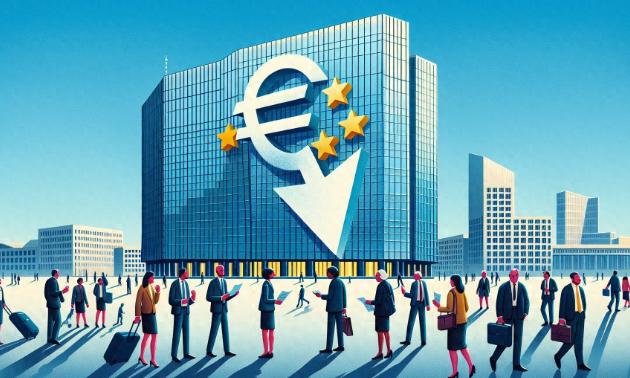
In the face of continued weak economic growth and falling inflation expectations, the European Central Bank finally made another "rate cut" on September 12, cutting the key deposit rate by 25 basis points to 3.5%, while the main refinancing and marginal lending rates were cut by 60 basis points respectively. Trying to give a shot in the arm to a sluggish economy.
From the economic data point of view, the eurozone GDP growth slowed down in the second quarter, and the year-on-year CPI growth rate hit a new low in August, which provides sufficient conditions for interest rate cuts, and the growth data of key economies such as Germany is also lower than expected, further aggravating the market's concern about the economic outlook of the eurozone. As a result, the ECB's decision to cut interest rates at this meeting was unanimous and supported by both hawkish and dovish members of the Governing Council.
The ECB's rate cut was large, but it showed a cautious approach by not making a clear commitment to the future path of interest rates. Due to global economic uncertainty, geopolitical risks and commodity price volatility, the eurozone economy may face greater challenges in the future, which may also lead the ECB to accelerate the pace of interest rate cuts in the future.
Although the European Central Bank hopes to boost the economy by cutting interest rates, the reality is far more complex than imagined, the eurozone economy is not facing simple cyclical fluctuations, but deeper structural contradictions and huge uncertainties in the external environment, the European economy is facing obstacles and long economic difficulties, whether it can effectively use the "rate cut killer" to recover the eurozone weakness. It will pose a severe test for the whole of Europe.
First of all, from the historical data, the European Central Bank usually adopts loose monetary policies such as interest rate cut to stimulate economic growth and inflation in the face of economic downward pressure, but the effect of interest rate cut is not always immediate, especially in the context of large heterogeneity among member states, a single monetary policy is difficult to meet the needs of all countries at the same time. In addition, there are internal differences in the ECB's policy decision-making process, which may lead to inconsistency in the implementation of policies, thus affecting the stability of policy effects.
Second, although interest rate cuts can provide liquidity support in the short term, in the long run, if inflation expectations are not effectively controlled, it may lead to new economic problems, as the experience of the European Central Bank's interest rate cut in June shows, although the negative interest rate policy can help reduce financing costs in the short term, it may also have a negative impact on the banking industry, and even threaten the stability of financial institutions.
Third, the outlook for economic growth in the euro area remains uncertain, with limited growth momentum despite weak signs of recovery and multiple external challenges such as global geopolitical tensions, rising trade protectionism and the energy transition, which could lead to lower demand for euro area exports and thus drag down economic growth.
The eurozone economy has long suffered from structural problems such as labor market rigidity, lack of innovation capacity, and high government debt. These problems cannot be solved overnight, and monetary policy alone cannot be effective.
In short, the European Central Bank announced the second interest rate cut this year, is a panacea or drink poison to quench thirst, the answer is not yet known, although the rate cut is large, but due to the uncertainty of future economic data and inflation, its future interest rate path has not made a clear commitment, which means that the eurozone economy may face greater challenges. This is especially true in the face of increasing global economic competition and weak domestic economic recovery.

On December 29th, Mar-a-Lago in Florida, USA, witnessed a highly anticipated diplomatic meeting - a dialogue between US President Trump and Israeli Prime Minister Netanyahu.
On December 29th, Mar-a-Lago in Florida, USA, witnessed a h…
SoftBank Group announced on Monday that it has agreed to ac…
Recently, the US State Department issued a visa ban, adding…
On January 20, 2025, just 13 days after taking office, Trum…
On December 19, 2025, the U.S. Department of Energy, along …
The relationship between the Trump administration and the U…